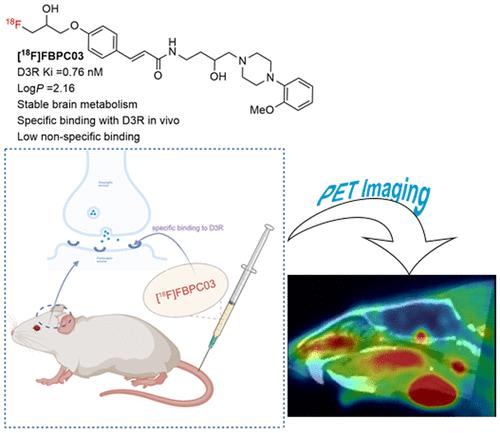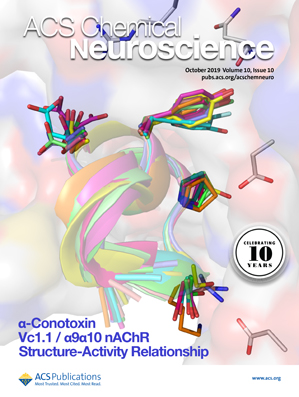用于正电子发射断层成像的 18F 标记苯基哌嗪样多巴胺 D3 受体放射性配体的合成与评估
IF 3.9
3区 医学
Q2 BIOCHEMISTRY & MOLECULAR BIOLOGY
引用次数: 0
摘要
多巴胺 D3 受体(D3R)在抑郁症、双相情感障碍、精神分裂症、药物成瘾和帕金森病等各种神经精神疾病的病理生理学中起着重要作用。使用创新放射性配体的正电子发射断层扫描(PET)为评估体内 D3R 和阐明与 D3R 相关的疾病机制提供了机会。在此,我们合成了八种 18F 标记的苯基哌嗪类 D3R 选择性放射性配体,它们具有良好的放射化学纯度(97%)、体外稳定性(95%)和亲油性。根据体外结合试验和静态 microPET 研究,选择了苯基哌嗪类放射性配体 [18F]FBPC01 和 [18F]FBPC03 作为靶向 D3R 的先导放射性配体。分子对接进一步阐明了它们的结合机制。经过优化的放射性标记条件被应用于自动化的放射性标记过程,得到了具有高特异性活性(>112 GBq/μmol)的产品。大鼠动态 PET 研究表明,[18F]FBPC01 和 [18F]FBPC03 与脑室和垂体中的 D3R 具有特异性结合。通过动态PET数据分析、生物分布研究和代谢分析验证,[18F]FBPC03的PET信噪比最高,在大鼠脑室和垂体中的D3R特异性结合良好,脱靶结合少,脱氟可以忽略不计,脑代谢稳定,表明[18F]FBPC03是一种很有前途的D3R放射性配体。本文章由计算机程序翻译,如有差异,请以英文原文为准。

Synthesis and Evaluation of 18F-Labeled Phenylpiperazine-like Dopamine D3 Receptor Radioligands for Positron Emission Tomography Imaging
The dopamine D3 receptor (D3R) is important in the pathophysiology of various neuropsychiatric disorders, such as depression, bipolar disorder, schizophrenia, drug addiction, and Parkinson’s disease. Positron emission tomography (PET) with innovative radioligands provides an opportunity to assess D3R in vivo and to elucidate D3R-related disease mechanisms. Herein, we present the synthesis of eight 18F-labeled phenylpiperazine-like D3R-selective radioligands possessing good radiochemical purity (>97%), in vitro stability (>95%), and befitting lipophilicity. Based on in vitro binding assays and static microPET studies, the phenylpiperazine-like radioligands [18F]FBPC01 and [18F]FBPC03 were chosen as lead radioligands targeting D3R. Molecular docking further elucidated their binding mechanism. Radiolabeling conditions were optimized and then applied to an automated radiolabeling process, affording products with high specific activity (>112 GBq/μmol). Dynamic rat PET study demonstrated the specific binding of [18F]FBPC01 and [18F]FBPC03 to D3R in the brain ventricles and the pituitary gland. Validated by dynamic PET data analysis, biodistribution study, and metabolism analysis, [18F]FBPC03 exhibited the highest PET signal-to-noise ratio, good D3R-specific binding in the brain ventricles and pituitary gland of rats with few off-target binding, negligible defluorination, and stable brain metabolism, which indicated that [18F]FBPC03 was a promising D3R radioligand.
求助全文
通过发布文献求助,成功后即可免费获取论文全文。
去求助
来源期刊

ACS Chemical Neuroscience
BIOCHEMISTRY & MOLECULAR BIOLOGY-CHEMISTRY, MEDICINAL
CiteScore
9.20
自引率
4.00%
发文量
323
审稿时长
1 months
期刊介绍:
ACS Chemical Neuroscience publishes high-quality research articles and reviews that showcase chemical, quantitative biological, biophysical and bioengineering approaches to the understanding of the nervous system and to the development of new treatments for neurological disorders. Research in the journal focuses on aspects of chemical neurobiology and bio-neurochemistry such as the following:
Neurotransmitters and receptors
Neuropharmaceuticals and therapeutics
Neural development—Plasticity, and degeneration
Chemical, physical, and computational methods in neuroscience
Neuronal diseases—basis, detection, and treatment
Mechanism of aging, learning, memory and behavior
Pain and sensory processing
Neurotoxins
Neuroscience-inspired bioengineering
Development of methods in chemical neurobiology
Neuroimaging agents and technologies
Animal models for central nervous system diseases
Behavioral research
 求助内容:
求助内容: 应助结果提醒方式:
应助结果提醒方式:


